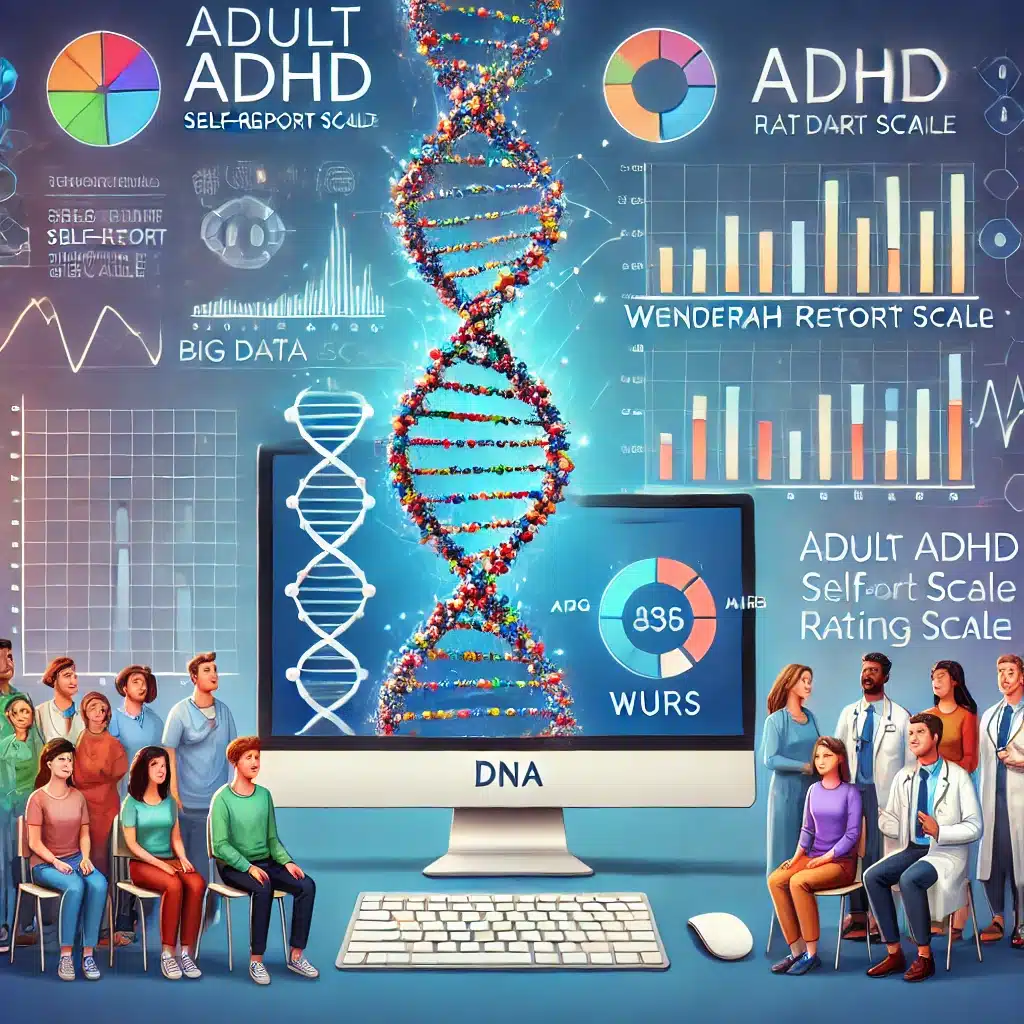The ADHD polygenic score (PGS) adds slight yet statistically significant value to existing ADHD diagnostic tools, though it currently lacks clinical utility.
Highlights:
- Study Overview: Researchers tested if adding a genetic score (ADHD PGS) to traditional diagnostic tools (ASRS and WURS scales) and family history could better predict ADHD.
- Improvement in Diagnosis: Adding the ADHD genetic score slightly improved the accuracy of existing diagnostic tools:
- Statistical Findings: These improvements were statistically significant, meaning they were unlikely to have happened by chance.
- Current Practical Use: Despite the statistical improvements, the genetic score currently adds only a small increase in accuracy and isn’t practical for everyday diagnosis.
Source: BMC Psychiatry (2024)
Major Findings: Polygenic Scores vs. ADHD Diagnostics (2024)
1. Increased Diagnostic Accuracy
ADHD Genetic Score (PGS) Contribution: Adding the ADHD PGS slightly improved the accuracy of existing diagnostic tools:
- ASRS (Adult ADHD Self-Report Scale): Improved by 0.58% (from 61.11% to 61.69%)
- WURS (Wender-Utah Rating Scale): Improved by 0.61% (from 77.33% to 77.94%)
- Combined ASRS and WURS: Improved by 0.57% (from 80.84% to 81.40%)
- Family History: Improved by 1.40% (from 28.06% to 29.46%)
Adding the ADHD PGS to these tools resulted in a small but measurable increase in how much of the variation in ADHD symptoms could be explained.
Essentially, the genetic score helps a little in making the diagnosis more precise.
2. Statistical Significance
Likelihood Ratio Tests: The ADHD PGS significantly improved the model fit:
- Basic Model vs. Model with PGS: The improvement was highly significant (p < 0.0001)
- ASRS alone vs. ASRS with PGS: The improvement was significant (p = 0.0381)
- WURS alone vs. WURS with PGS: The improvement was significant (p = 0.0048)
- Combined ASRS and WURS vs. Combined with PGS: The improvement was significant (p = 0.0103)
These tests show that the addition of the ADHD PGS meaningfully enhances the existing models used to diagnose ADHD, making them statistically more accurate.
3. Model Comparison
Akaike Information Criterion (AICc): Models including the ADHD PGS had a better fit compared to those without it:
- Best Fit: The model with ASRS, WURS, and PGS had the best fit (AICc = 474.96)
- Next Best Fit: The model with just ASRS and WURS was the next best (AICc = 479.52)
A lower AICc value indicates a model that better balances accuracy and complexity.
The model with the ADHD PGS had a noticeably better balance, making it more reliable.
4. Improvement in Predictive Power
Lee R² Measure: The ADHD PGS increased the explained variance (how much of the ADHD traits can be accounted for by the model):
- Basic Model: Increased by 1.518% (from 16.085% to 17.603%)
- ASRS: Increased by 0.577% (from 61.109% to 61.686%)
- WURS: Increased by 0.610% (from 77.326% to 77.936%)
- Combined ASRS and WURS: Increased by 0.565% (from 80.838% to 81.402%)
The Lee R² measure indicates that the ADHD PGS adds some predictive power to the models, helping them to better explain ADHD symptoms.
5. Family History Integration
The ADHD PGS provided additional useful information beyond just knowing if there is a family history of ADHD.
However, knowing the family history alone explained more of the ADHD symptoms than the ADHD PGS.
While the genetic score adds value, knowing about ADHD in the family is still more informative by itself.
6. Sensitivity Analyses
Associations: The ADHD PGS was significantly linked to higher scores on the ASRS, ASRS-screener, WURS, and self-reported family history of ADHD:
- ASRS: Highly significant (p < 0.001)
- ASRS-screener: Highly significant (p < 0.001)
- WURS: Highly significant (p < 0.001)
- Family History: Significant (p = 0.039)
These results confirm that the ADHD PGS is associated with higher scores on ADHD symptom scales and a reported family history of ADHD.
7. Clinical Utility: Not Ready
Current Utility: Despite being statistically significant, the ADHD PGS currently adds only a small amount of extra explanatory power to standard diagnostic tools, and is not yet useful in clinical practice.
Future Potential: The ADHD PGS might become more useful in the future, especially if combined with other risk factors, as more genetic data becomes available and analytical methods improve.
The genetic score is not ready for use in everyday clinical settings yet but has potential for future applications in ADHD prediction and diagnosis.
Study Overview: Polygenic Score (PGS) vs. ADHD Diagnosis (2024)

The study aimed to investigate whether the ADHD polygenic score (PGS) can enhance the diagnostic accuracy of attention-deficit/hyperactivity disorder (ADHD) by providing additional information alongside traditional ADHD rating scales and family history.
Sample
Participants: 576 adults diagnosed with ADHD and 530 ethnically matched controls.
Demographics: ADHD group: 51.2% female, mean age 34.3 years vs. Control group: 61.9% female, mean age 28.1 years.
Methods
Polygenic Score Calculation: Using summary statistics from the 2023 ADHD GWAS meta-analysis.
Rating Scales: Wender-Utah Rating Scale (WURS) & Adult ADHD Self-Report Scale (ASRS)
Statistical Analysis: Nested logistic regression models to predict ADHD diagnosis. Likelihood ratio (LR) tests, Akaike Information Criterion (AICc), and Lee R² for model comparison. Inclusion of family history of ADHD as a covariate in all models.
Limitations
- Population Specificity: Sample limited to Norwegian adults, which may affect generalizability to other populations.
- Age and Diagnosis: Focus on adults with persistent childhood-onset ADHD; results may not apply to children or adolescents.
- Diagnostic Tools: The study used full scores of ASRS and WURS rather than their factor structures, which might influence the diagnostic accuracy.
- Clinical Utility: The study was not designed to evaluate the ADHD PGS in actual clinical settings, and its practical use in diagnostics remains limited.
Is the ADHD PGS Cost-Effective? Unlikely.

Marginal Improvement
Small Increase in Variance Explained: The ADHD PGS increased the explained variance by 0.58% to 1.40% depending on the diagnostic tool used. This small gain in predictive power may not justify the additional costs involved in genetic testing.
Costs Involved
Genetic Testing: Conducting genetic tests to calculate the ADHD PGS involves costs related to sample collection, genotyping, and data analysis. These costs can be substantial, especially when applied on a large scale.
Clinical Integration: Integrating genetic testing into standard clinical practice would require additional training for healthcare providers, adjustments to diagnostic protocols, and possibly new infrastructure, further increasing the costs.
Comparison with Existing Methods
Current Diagnostic Tools: Existing diagnostic tools like the ASRS, WURS, and family history assessments are already well-established, cost-effective, and relatively easy to administer. They provide substantial diagnostic accuracy without the need for expensive genetic testing.
Family History: Knowing a patient’s family history of ADHD remains a more powerful predictor than the ADHD PGS. Gathering this information is straightforward and low-cost compared to genetic testing.
Practical Considerations
Clinical Utility: Despite its statistical significance, the ADHD PGS’s contribution to diagnostic accuracy is small. This marginal gain may not translate into a meaningful clinical benefit that justifies the expense.
Ethical and Psychological Factors: Genetic testing can have ethical implications and may cause anxiety or confusion for patients and families, particularly if the added benefit is minimal.
Future Improvement: Whole Genome Analysis for ADHD Diagnosis
Comprehensive Genetic Data
- Whole Genome Analysis: Unlike the current polygenic score, which is based on specific known genetic markers, whole genome analysis examines the entire genetic makeup. This comprehensive approach can identify additional genetic variants associated with ADHD, leading to a more accurate and detailed genetic profile.
- Rare Variants: Whole genome sequencing can detect rare genetic variants that may have a substantial impact on ADHD but are not captured by current PGS models focused on common variants.
Integration with Big Data Informatics
- Big Data Analytics: Advanced big data analytics can integrate vast amounts of genetic data with other types of data (e.g., environmental factors, neuroimaging, clinical histories). This integration can uncover complex interactions between genes and environment that contribute to ADHD, leading to more robust diagnostic models.
- Machine Learning: Machine learning algorithms can analyze large datasets to identify patterns and predict ADHD more accurately. These algorithms can continuously improve as more data becomes available, refining their predictive power over time.
Multi-Factorial Analysis
- Holistic Approach: Future models can combine genetic data with behavioral, cognitive, and environmental data to create a multi-dimensional view of ADHD. This holistic approach can enhance diagnostic precision and personalize treatment strategies.
- Risk Stratification: Advanced models can provide better risk stratification, identifying individuals at high risk of ADHD earlier and more accurately, potentially leading to earlier interventions and better outcomes.
Continuous Learning and Adaptation
- Dynamic Models: Big data and machine learning enable the creation of dynamic models that can adapt and improve with new data inputs. These models can become increasingly precise as they incorporate findings from ongoing research and clinical practice.
Conclusion: ADHD Polygenic Scores for Diagnostic Enhancement
In conclusion, the study found that while the ADHD polygenic score (PGS) contributed additional information to traditional diagnostic tools like the ASRS, WURS, and family history assessments, the improvement in diagnostic accuracy was marginal.
This small gain does not currently justify the cost and complexity of integrating genetic testing into routine clinical practice.
However, the potential for future advancements in whole genome analysis and big data informatics holds promise for significantly enhancing ADHD diagnostic models.
These future technologies could provide a more comprehensive and precise understanding of the genetic and environmental factors contributing to ADHD, leading to earlier and more accurate diagnoses.
As genomic technologies advance and become more cost-effective, the integration of these sophisticated tools into clinical settings may revolutionize ADHD diagnosis and treatment, ultimately improving patient outcomes.
Continued research and technological development are essential to realize this potential and ensure ethical and practical implementation.
References
- Study: Using polygenic scores in combination with symptom rating scales to identify attention-deficit/hyperactivity disorder (2024)
- Authors: André Høberg et al.







